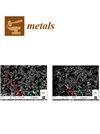Full Density Powder Metallurgical Cold Work Tool Steel through Nitrogen Sintering and Capsule-Free Hot Isostatic Pressing
IF 2.5
3区 材料科学
Q3 MATERIALS SCIENCE, MULTIDISCIPLINARY
引用次数: 0
Abstract
Vanadis 4E (V4E) is a powder metallurgical cold work tool steel predominantly used in application with demand for wear resistance, high hardness, and toughness. It is of interest to have a processing route that enables full density starting from clean gas-atomized powder allowing component shaping capabilities. This study presents a process involving freeze granulation of powder to facilitate compaction by means of cold isostatic pressing, followed by sintering to allow for capsule-free hot isostatic pressing (HIP) and subsequent heat treatments of fully densified specimens. The sintering stage has been studied in particular, and it is shown how sintering in pure nitrogen at 1150 °C results in predominantly closed porosity, while sintering at 1200 °C gives near full density. Microstructural investigation shows that vanadium-rich carbonitride (MX) is formed as a result of the nitrogen uptake during sintering, with coarser appearance for the higher temperature. Nearly complete densification, approximately 7.80 ± 0.01 g/cm3, was achieved after sintering at 1200 °C, and after sintering at 1150 °C, followed by capsule-free HIP, hardening, and tempering. Irrespective of processing once the MX is formed, the nitrogen is locked into this phase and the austenite is stabilised, which means any tempering tends to result in a mixture of austenite and tempered martensite, the former being predominate during the sequential tempering, whereas martensite formation during cooling from austenitization temperatures becomes limited.通过氮气烧结和无胶囊热等静压工艺生产全密度粉末冶金冷作工具钢
Vanadis 4E (V4E) 是一种粉末冶金冷作工具钢,主要用于需要耐磨性、高硬度和韧性的应用领域。人们希望有一种加工方法,能从清洁的气体原子化粉末开始,实现全密度加工,从而使部件具有成型能力。本研究提出了一种工艺,包括粉末冷冻造粒,以便通过冷等静压法进行压实,然后进行烧结,以实现无胶囊热等静压(HIP),并对完全致密化的试样进行后续热处理。我们特别对烧结阶段进行了研究,结果表明,在 1150 °C 的纯氮环境下烧结主要会产生闭合孔隙,而在 1200 °C 的环境下烧结则会产生接近全密度的孔隙。微观结构研究表明,烧结过程中的氮吸收形成了富钒氮化碳(MX),温度越高,MX 越粗大。在 1200 °C 烧结和 1150 °C 烧结后,经过无胶囊 HIP、淬火和回火,几乎实现了完全致密化,密度约为 7.80 ± 0.01 g/cm3。无论采用何种加工工艺,MX 一旦形成,氮就会被锁定在这一相中,奥氏体就会稳定下来,这意味着任何回火都会产生奥氏体和回火马氏体的混合物,前者在连续回火过程中占主导地位,而在从奥氏体化温度冷却过程中形成的马氏体则会受到限制。
本文章由计算机程序翻译,如有差异,请以英文原文为准。
求助全文
约1分钟内获得全文
求助全文
来源期刊

Metals
MATERIALS SCIENCE, MULTIDISCIPLINARY-METALLURGY & METALLURGICAL ENGINEERING
CiteScore
4.90
自引率
13.80%
发文量
1832
审稿时长
1.5 months
期刊介绍:
Metals (ISSN 2075-4701) is an open access journal of related scientific research and technology development. It publishes reviews, regular research papers (articles) and short communications. Our aim is to encourage scientists to publish their experimental and theoretical results in as much detail as possible. Therefore, there is no restriction on the length of the papers. The full experimental details must be provided so that the results can be reproduced. Metals provides a forum for publishing papers which advance the in-depth understanding of the relationship between the structure, the properties or the functions of all kinds of metals.
 求助内容:
求助内容: 应助结果提醒方式:
应助结果提醒方式:


